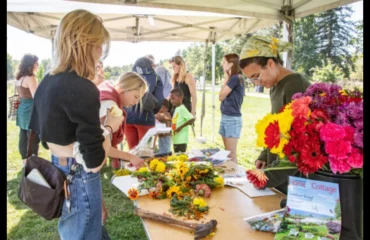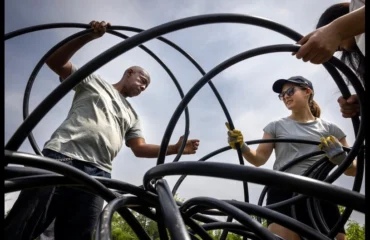Engaging with Detroit
https://www.youtube.com/watch?v=6DbtCrmRF50
So there they were, all 24 UM students, crowded into the small studio, singing a cappella — and from memory:
I’ve got sunshine on a cloudy day. When it’s cold outside, I’ve got the month of May. I guess you’d say What can make me feel this way? My girl, my girl, my girl Talkin’ ’bout my girl –my girl!
As they finished the last words, the group burst out laughing and clapping — these young folks who were born more than 30 years after the original Motown hit was recorded by the Temptations.
But they weren’t just singing this song. They were singing it in the very same place where it first was recorded in 1964. That studio, featuring the most rudimentary equipment, was a converted garage connected to a modest house on West Grand Boulevard in Detroit – the place Motown Records itself was established by Berry Gordy, Jr. in 1960. Since 1985, the house has been a museum called “Hitsville,” a vibrant walk through history right where it all took place.
In fact, before they broke out in song, the students went through the museum; listened to their tour guide’s narrative about Gordy’s entrepreneurial prowess; saw original 45 Motown hit records; and watched a video showing old, grainy, black and white televisions shows of Martha and the Vandellas singing “Dancing in the Streets,” Diana Ross and the Supremes, and other young Motown artists.
There had been more to the day’s learning for these students. Just prior to the tour of Hitsville, back at the University of Michigan Detroit Center, students learned all about The Motor City in the 1960s. They watched a video about the 1967 riots, full of television images from that unhappy time. They read lyrics to several Motown hits and discussed the significance of all that happy singing and social unrest.
All of this was part of a class at U-M’s Detroit Center on the city’s history, taught by Dr. Stephen Ward, associate professor in the Residential College (RC) and the Department of Afroamerican and African Studies.
Then they piled into cars and went to the corner of Rosa Parks Boulevard (in ’67, it was 12th Street) and Clairmount Avenue – the very corner where the riots began. Now a modest park bearing benches, trees and a metal sculpture – but no historic marker – the students listened to Ward and Dr. Angela Dillard, director of the RC, whose parents lived in the area when she was a kid, prior to and during the riots.
The area formerly had been a Jewish neighborhood, Dillard explained as students circled around. By 1967, most had moved to the suburbs and this area had become a “transitional” neighborhood of African-Americans – and pretty much the only place they were “allowed” to live, given the racial constructs of the time.
“This was a very dense neighborhood,” Dillard said. “People were just packed into this area. It was crowded, hot,” and residents were frustrated. When police raided a blind pig in the basement of the printing company July 23, the place exploded.
As they stood there in that quiet park and then, later, in the Motown studio, the students were transfixed by what they were seeing and learning.
It was all so …. evocative.
And it was all so Semester In Detroit.
This day’s events, which occurred in June, were typical of what students do, and how they do it, during U-M’s Semester In Detroit (SID) program, which is entering its fourth year and has become quite popular. The comprehensive program’s three pillars requiring students to live, study and work in Detroit, totally immerses students in a city most of them know little about.
“I have always been a fan of Motown, but to be honest, I had never really associated it with Detroit,” admits one of the students, Mary Naoum, 20, a sophomore majoring in theater arts. “Learning about Motown in class and going to the museum made me proud to be associated with Detroit.”
Such sentiment is proof of SID’s effectiveness as a dynamic, nontraditional approach to teaching and learning, says Craig Regester, SID associate director. “The combination and interplay among the three core components of SID — living, studying and working in Detroit — is what we believe makes us most distinctive. Each of these three programmatic aspects strengthens and illuminates the others; ultimately, this enables our students to engage with Detroit in substantive and serious ways.
“Detroit is an incredibly important, historic and vibrant city,” continues Regester, who has lived here since 1995. “It’s important to find ways to integrate our courses with the landscape of the city.”
The total program includes traditional classes focusing on Detroit, such as “Planning Detroit: Past, Present, Future;” the community-based internship; Internship Reflection Seminar; a Detroit Speaker Series, which features visits by some of the city’s leaders and prominent citizens; and elective courses. Students can take courses at Wayne State University.
By completing SID and taking one required class on Ann Arbor’s campus, students can earn the LSA Minor in Urban Studies. The entire SID program is funded by the Office of the Provost and administered through the Residential College, though students do not have to be in the RC to enroll in SID. The program also receives support from LSA.
Excursions to various Detroit sites such as the 1967 riot park and Hitsville, says Dr. Ward, “are a central part of the class. This class meets every Tuesday and Thursday. On Tuesdays, we meet in the classroom and discuss the week’s readings, supplemented with viewing documentaries, listening to music, analyzing primary source documents. On Thursdays, we take trips somewhere in the city related to the class sessions. These excursions vary. We have been to places such as the old Packard Plant, the Guardian Building, the Ossien Sweet home, the DIA (Detroit Institute of Arts). One week we took the Ford Rouge Plant tour.”
The SID program’s partners – nonprofit and community organizations that students intern with during the semester – are a crucial part of that student-city integration, says Dillard. “We’re committed to the internship component, which places students in a variety of places, ranging from the Museum of Contemporary Art Detroit, to the Hub,” a nonprofit bicycle reuse and repair shop, “to the offices of individual elected officials, to New Detroit and many more.” Students must work 16 hours per week at their internships.
Originally the idea of four U-M students, says Regester, SID “redefines both the real and imagined boundaries of the traditional classroom. The program enables students to maintain a constant dialogue among theory, history and practice as they intertwine their everyday lives with this great American city.”
Naoum, who grew up in Troy, Mich., was a typical suburban youth who learned about Detroit through the lens of her parents, who shared the widespread view that Detroit was in decline – a vision certainly not incorrect, especially in recent decades. But she also had started exploring Detroit with her friends in high school, and found a city vibrant, full of life, art, theater and spontaneity.
Naoum’s career goal to help produce social change through theater led her to SID. She lived in the city, studied at the Detroit Center and interned at The Matrix Theatre Company (matrixtheatre.org), a nonprofit theater in southwest Detroit that is “aimed at using the transformative power of theatre to create social change,” Naoum says. She shadowed the executive director and also acted as the Community Engagement Coordinator. During her time there, the company was working on its “Ghost Waters Initiative,’ which is focused on environmental sustainability in Detroit.
She absolutely loved every minute of the entire SID program, she says. And, “as the term continued, I came to realize that, yes, my parents’ interpretation of the city’s current state has validity. But so did my high school view! One view without the other is an incomplete narrative of the city.”
One of Naoum’s fellow SID students, Sam Morykwas, a 21-year-old political science major and also a Troy, Mich. native, couldn’t agree more. Unlike Naoum, prior to his SID experience, Morykwas already had been volunteering in Detroit with a nonprofit called Neighbors Building Brightmoor. Brightmoor is an older Detroit neighborhood on the rebound. Regester agreed to add that nonprofit to the growing list of SID partners, and Morykwas was able to continue his ongoing work in the area.
“I love the people and community there, so I wanted to use the internship to further deepen my connection,” Morykwas says. He helped by working with youth in art workshops; career training of high schoolers with the Brightmoor Youth Development Collaboration; building the organization’s website; participating in monthly meetings; and passing out fliers door-to-door. It was total immersion and a lesson in life: he saw people fight to save their neighborhood one day and a friend’s car get stolen the next.
“I think the most important thing is just how the true story of Detroit lies in contrasts. It is not solely about the crime and struggles, but it is also not just about successes of new towns and organizations,” Morykwas says. “It is about the back-and-forth Detroiters face every day with bombardments from each side. You could see something that will mess up your whole perspective one day and the very next be part of something that gives you more hope than ever.”
Such comments, and blog posts on the SID website, overwhelmingly prove the popularity of the program. But exactly how is its success really measured? Says Dillard, “SID uses the same assessment modules as any other class. Students complete coursework, including research papers, creative projects and other assignments, which are graded in conventional ways with letter grades.
“But in a larger sense, we measure our success by the levels of engagement students demonstrate in the various aspects of the learning experience, especially work at their internship sites – for which they produce final projects and papers – and the reflection essays and discussions that occur weekly as part of the Reflection Seminar.
“We also are beginning to increasingly chart the subsequent experience of SID alums,” Dillard continues. “If a student decides to spend the following summer, after the term, living and working productively in Detroit, then we judge that as a success.” Several have done so, she says. “Other alums have taken longer-term positions at their former internship sites, while still others have gone on to do graduate work directly inspired by their experiences in the city.”
So how do Naoum and Morykwas stack up on that measure? Well, let’s see:
Morykwas, now living back in Ann Arbor, is still working to strengthen the partnership between Neighbors Building Brightmoor (neighborsbuildingbrightmoor.org) and the U-M team, a student organization dedicated to that connection, he says. His personal goal as one of the founding members of the group is to transition leadership further to younger members, and to help guarantee the connection’s longevity.
Naoum still lives in Detroit and is the Reflection and Dialogue Director for the service non-profit, Summer In The City. Through this group, she helps high school students volunteer in Detroit’s urban gardens and paint murals, and she also works with kids at a summer day camp. She is the Community Partner Coordinator for this Summer In The City, and interacts with some of the city’s largest employers.
Impressive, for sure. But of course, all of this is not just a matter of community involvement or academic success. It’s personal.
As Naoum puts it: “I am now so emotionally invested in Detroit.”
For more information and to apply for SID’s Winter 2013 program, go to www.semesterindetroit.com
Sheryl James is a Pulitzer Prize-winning, freelance journalist from Brighton, Mich.


